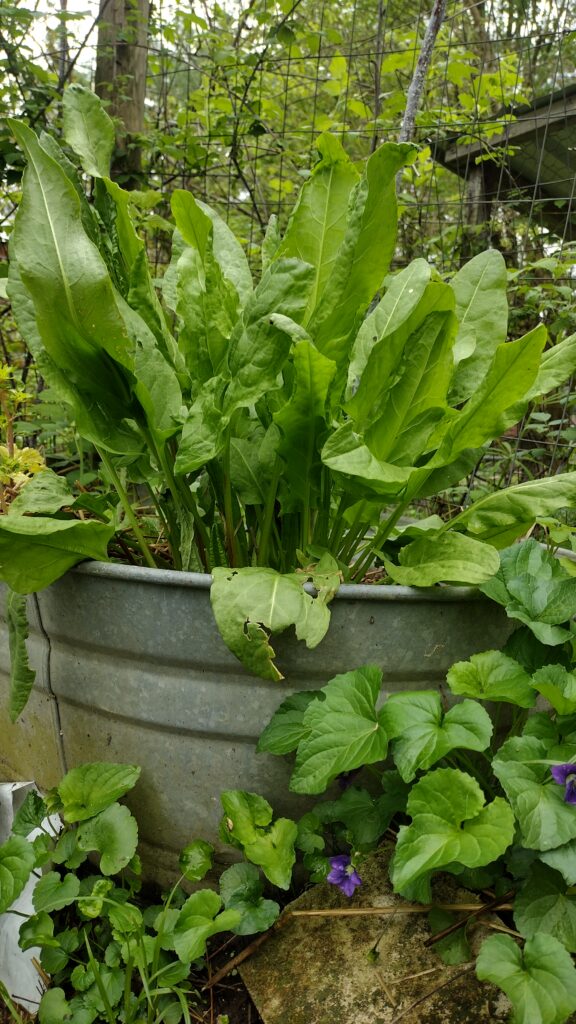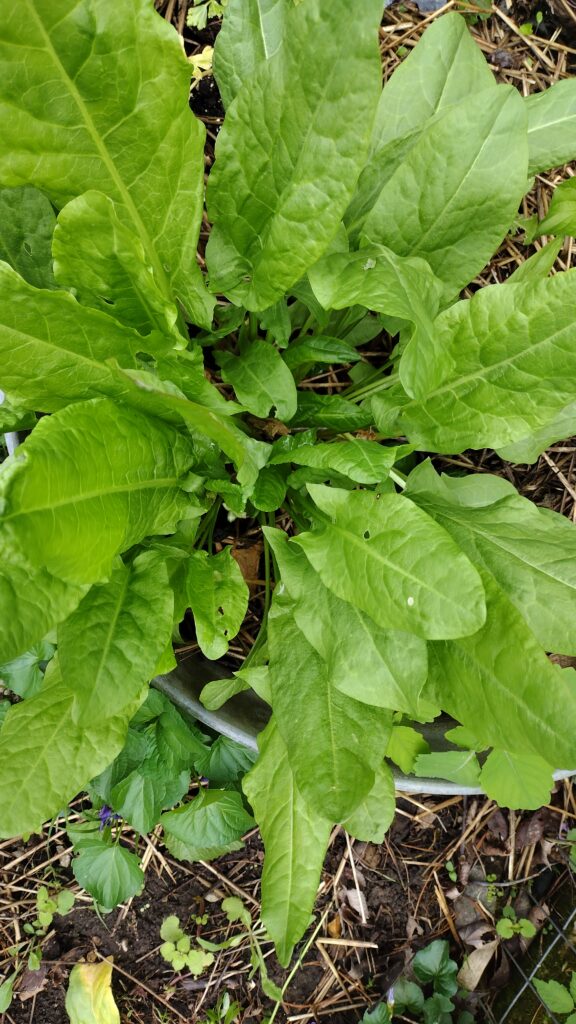Garden Sorrel
Rumex acetosa
Garden sorrel is a hardy perennial with lemony flavored leaves, it is often used in soups, sauces, and the young tender leaves in salads. It contains high levels of vitamin A and vitamin C. It is a perennial herbaceous plant that does well in moist conditions, such as in woodlands and streams. It belongs to the family Polygonaceae, and is native to in Eurasia.
Height: 12″
Zones:
Days to Harvest: 40 to 60
Container: yes
Deer Resistant: yes
Plant Color: green
Bloom Color: —
Life Cycle: perennial
Spacing:
Juglone Tolerant: no
Sunlight: sun to shade
Soil: moist
Water: higher
Design Styles: potager, woodland, herb and cottage gardens
Guild Use:

History
During the time of Henry VIII, garden sorrel was popular, but with the introduction of French sorrel, which has a milder flavor, garden sorrel fell out of use and even ceased to be cultivated for many years. Sorrel is also commonly known as Dock.
Because sorrel is best when used fresh, young and in the early spring, you will rarely see it in super markets or even in recipes, as it is known to now be difficult to locate.
Traditionally, it’s said that in England, children and country folk eat the leaves to remedy thirst.
There are many varieties of sorrel, including Wood Sorrel, found in the U.S. woodlands and cooler locations, and French Sorrel, which prefers dry locations with good soil drainage.
Uses
These are ways you can use this plant in your landscape or farm:
* potager or kitchen garden
* herb garden
* medicinal garden
* greenery in a moist forest garden
Design
Garden Sorrel grows best in areas that have a consistently moist soil. This can be a forest or woodland garden, next to a stream or a partially shaded pond edge, or even in a container sized for the plant. Be sure the soil mixture contains enough structure to hold in moisture for best growth.

Benefits
By choosing this plant, the benefits are that you have a low care lemony addition to soups and salads.
Be aware that slugs can be an issue, and some leaf eating insects find it tasty. Sorrel can be grown and thrive with minimal interventions, especially when located in a place that meets its sun, moisture, and soil needs.
Sorrel is best when used fresh, young and in spring, although can be harvested from early spring to fall once established.
It is rarely stocked in super markets or included in recipes, since it can be quite difficult to locate. Growing your own is the best source of this wonderful herb.
Amount per 1 cup slices (133g)
Calories 29
Total Fat .9 g
Saturated fat 0 g
Cholesterol 0 mg
Sodium 5.3 mg
Potassium 644mg
Total Carbohydrate: 4.2 g
Dietary fiber 3.9 g
Sugar – 0 g
Protein 2.6 g
___________________________________
Vitamin A 106%
Vitamin C 106%
Magnesium 137mg
Iron 3.2mg
Folate 4%
Manganese 0.5mg
Magnesium 137mg
% Daily Value
-%
0%
0%
-%
18%
8%
9%
6%
___________________________________
Calcium 59mg
Manganese 0.5mg
Potassium 519mg
Phosphorus 84mg
– contains small amounts of sodium, zinc,
copper, and other essential nutrients.
Parting Thoughts
In cooking, sorrel is often paired with goat cheese, eggs and poultry. Do not cook sorrel in cast iron or aluminum cookware. The oxalic acid in sorrel reacts with the metals to produce a metallic flavor.
Rezenience Gardens and Design is mission-driven and specializes caring for people and planet.
We do this by providing the most healthful varieties of plants, fruits, and seeds, through
environmentally sound design services, and by means of education.
#PeopleAndPlanet
@Rezenience
